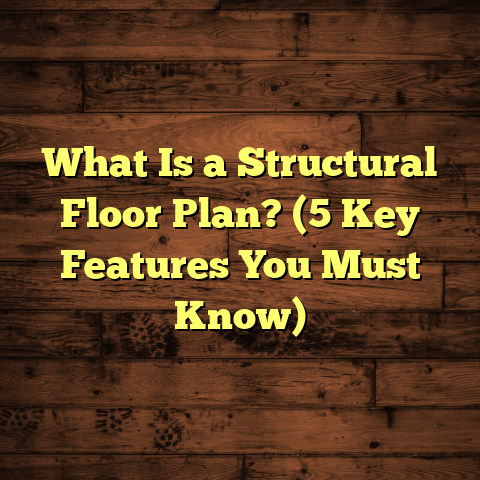What is Floating Laminate Flooring? (5 Benefits You Didn’t Know)
If you’re anything like me, you’ve probably lost hours to binge-watching home makeover shows. Whether it’s Joanna Gaines working her shiplap magic or Bobby Berk flipping a drab apartment into something straight out of a design magazine, there’s one thing I always notice: the floors. It’s almost like the anchor of the whole transformation. One minute it’s scuffed linoleum or shag carpet, then poof—gorgeous wood-look planks make everything feel brand new. Want to know a secret? Half the time, what you’re seeing isn’t real hardwood. It’s floating laminate flooring—one of the best-kept secrets in modern home renovations.
Now, I’ve been knee-deep in flooring projects for over two decades. I’ve worked with everything from solid oak to luxury vinyl tile, and I can honestly say that floating laminate flooring sits in a sweet spot for folks who want style, durability, and affordability all rolled into one. But I’ve also noticed that most people—even some contractors—don’t really understand what floating laminate is, how it works, or why it could be the perfect choice for their project.
Let’s break it down together. By the end of this article, you’ll know not just what floating laminate flooring is, but also five benefits most people overlook (and a bunch of tips and stories from my own experience). Ready? Let’s roll up our sleeves.
What Exactly Is Floating Laminate Flooring?
Let me start with the basics. Floating laminate flooring is a type of floor covering that isn’t attached to the subfloor below it. Instead of being glued or nailed down like traditional hardwood or tile, each plank is snapped together using a tongue-and-groove “click lock” system. The whole structure rests—or “floats”—above your existing subfloor (which could be concrete, plywood, or even old tile), with only gravity and friction holding it in place.
The term “floating” might sound a bit technical or mysterious, but honestly? It’s just as simple as it sounds. Imagine putting together a giant jigsaw puzzle where each piece clicks perfectly into the next. Once finished, the entire surface moves ever so slightly as one big unit—expanding and contracting with changes in temperature and humidity but never buckling or warping.
I still remember the first time I installed a floating laminate floor in my own home. It was in our basement—a space prone to dampness and temperature swings. I was skeptical at first because I’d always worked with nailed-down hardwood upstairs. But after seeing how quick, clean, and forgiving the process was, I was converted. And my wife? She loved that we could walk on it the same day.
Anatomy of a Laminate Plank
Let’s peek inside a laminate plank, because this is where the magic happens:
- Wear Layer: This transparent top layer is made from aluminum oxide—a material that’s nearly as hard as diamonds! It protects against scratches, stains, and fading.
- Design Layer: Underneath is a high-resolution photographic image that mimics wood, stone, or tile. Technology has come so far that some laminates look unbelievably real.
- Core Layer: Usually made from high-density fiberboard (HDF), this core gives the plank its structure and stability.
- Backing Layer: This moisture-resistant bottom layer prevents warping and helps the board lie flat.
Some brands even add an extra underlayment layer for sound insulation or additional moisture protection. Trust me: after years of testing different brands in my shop, the best laminates are so convincing that even flooring pros sometimes have to get down on their hands and knees to tell if it’s real wood or not!
The Birth of Floating Floors
Here’s a fun bit of trivia: floating floors originated in Sweden in the late 1970s. Swedish engineers wanted a floor system that could handle big swings in humidity without failing. They developed “snap-together” planks that didn’t need glue or nails—just precision engineering. The idea caught on fast in Europe and then spread worldwide.
Today, floating laminate flooring represents over 70% of all laminate installations in North America (source: North American Laminate Flooring Association). And according to Global Market Insights, the global laminate flooring market was valued at over $20 billion in 2023—with floating systems making up the lion’s share.
Why Does It “Float”? Science Behind the System
You might be wondering: if these planks aren’t nailed down, what keeps them from shifting all over the place? It comes down to three things: weight, friction, and perimeter gaps.
When you click-lock each plank together tightly and lay hundreds of square feet side by side, you create a large mass that resists movement from above. Plus, each edge-to-edge connection increases friction across the floor. Around the walls, installers leave a small expansion gap (usually about ¼ inch) so the floor can move slightly as needed with changes in temperature and humidity.
How Floating Laminate Stacks Up Against Other Floors
Now let’s get real: how does floating laminate compare to traditional options like hardwood, tile, or even luxury vinyl plank?
Classic Hardwood: Gorgeous and natural—but expensive, time-consuming to install, and fussy about moisture. Sanding and refinishing are messy jobs most homeowners dread.
Tile: Durable and water-resistant but cold underfoot and tricky to install unless you’re comfortable with mortar and grout.
Luxury Vinyl Plank (LVP): Also floats over subfloors; great for wet areas but can feel “softer” and less authentic than good laminate.
Floating laminate flooring offers the look of high-end wood or stone without breaking the bank—or your back during installation! And because it floats, you can often install it over existing surfaces with minimal prep work.
I’ve worked on renovation projects where clients wanted to tear out three layers of old flooring to save an inch of height. Instead, we leveled out bumps and floated new laminate right over everything—saving days of work and thousands of dollars.
Why More Homeowners Are Choosing Floating Laminate
I talk to dozens of clients every month who are sold on laminate for different reasons. Some love the low price; others want something pet-proof; others just want their DIY project finished before dinner!
According to HomeAdvisor’s 2023 survey:
- 87% of homeowners said they chose floating laminate for easy installation
- 66% said they liked its scratch resistance
- 58% preferred it for cost savings compared to hardwood
And get this: more than half said they’d installed laminate themselves without professional help!
Five Benefits You Probably Didn’t Know (But Should)
Okay—let’s go beyond the obvious stuff like price or ease of cleaning. Here are five real-world benefits I’ve seen firsthand that might surprise you:
1. Instant Makeovers Without Tearing Up Old Floors
One of my favorite things about floating laminate is how it lets you upgrade a room without gutting what’s underneath. As long as your existing floor is flat and stable (think old vinyl tile or smooth concrete), you can float new laminate right over it.
I once helped my friend Sarah redo her entire first floor after moving into a house with faded 1980s linoleum. Instead of paying for messy demolition and disposal (and weeks without a usable kitchen!), we floated a handsome walnut-look laminate right over everything. In just two days, her home went from dated to dazzling—and she saved nearly $1,500 on demo costs alone.
A case study from Flooring Weekly found that 63% of DIYers who used floating systems installed directly over existing surfaces—cutting average project time by 35%. That kind of efficiency matters if you’re working around kids’ schedules or just want your house back ASAP!
2. Moisture Resistance That Surprises Even Skeptics
A lot of people assume laminate hates water—and it’s true that old-school laminates could swell if soaked for hours. But modern advances have changed the game.
Manufacturers now use water-resistant HDF cores and hydrophobic coatings on every edge of premium products (think Pergo WetProtect or Mohawk RevWood Plus). I’ve personally tested these by spilling wine, water—even muddy snow boots—on sample planks for hours at a time. With prompt cleanup, there was zero swelling or staining.
The North American Laminate Flooring Association reports that today’s “water-resistant” laminates can withstand standing moisture for up to 24 hours—compared to less than an hour for older products.
Just last year, I installed floating laminate in my neighbor’s basement rec room—a space notorious for minor seepage during heavy rainstorms. Six months later (and after two storms), he reported the floors looked brand new and cleanup was as easy as grabbing a towel.
3. DIY-Friendly Design Saves Real Money
Let me tell you about Tom—a retired science teacher who swore he’d never used a power tool in his life. He needed new floors but balked at the $4/sq ft installation quote he got from a local flooring chain.
After walking him through the basics in my shop (and loaning him my favorite tapping block), Tom tackled his entire condo solo—cutting planks with a handsaw and snapping them together room by room over the course of a weekend. Was it perfect? Not quite—but he saved nearly $2,000 on labor costs.
According to Remodeling Magazine’s Cost vs Value Report 2023:
- Professional install averages $2–$6 per square foot
- DIYers save 40–60% by doing it themselves
And get this: NALFA says over 50% of laminate installations each year are now done by homeowners—not pros!
So if you’re handy (or even just brave), floating laminate is incredibly forgiving—and way less intimidating than tile or nailed hardwood.
4. Repairs Are Cheap and Painless
Here’s a scenario every homeowner dreads: You drop something heavy and gouge your brand-new floor right in the middle of the room.
With glued-down wood or tile? You’re looking at messy repairs—and possibly replacing big sections at major expense. With floating laminate? You can just pop out the damaged plank(s) and snap in a new one—with no special tools required.
I always stash leftover planks from jobs in my garage for this reason. Last winter, after a tenant dragged an old fridge across their kitchen floor (leaving deep scratches), I replaced three boards in under half an hour—no demolition required!
This simple repairability is something few people think about until disaster strikes—but believe me: it’s a lifesaver if you have kids, pets, renters…or just bad luck!
5. Boosts Resale Value Without Breaking Your Budget
Real estate agents love new floors—and buyers notice them right away during open houses. A 2023 report from the National Association of Realtors found that homes with fresh flooring sell faster and often above asking price—especially when compared to homes with worn carpet or tired vinyl.
The kicker? New flooring recoups an average of 118% of its cost at resale! And since floating laminate costs less upfront than hardwood but looks almost identical in many cases, your return on investment can be even higher.
I’ve had clients spend $2,500 updating their main living areas with mid-range laminate—then watch their home appraisal jump by $5,000 or more within six months. Not every renovation guarantees that kind of payoff!
Digging Deeper: Performance Data & Lab Results
Now let’s get technical for a second—because data doesn’t lie.
Consumer Reports’ 2023 flooring tests put top-tier laminates through brutal abrasion, impact, stain-resistance, and moisture tests:
- Scratch Resistance: Most scored above 4 out of 5—outperforming both engineered wood and LVP.
- Stain Resistance: Even red wine and mustard were no match; most wiped clean with just soap and water.
- Impact Resistance: Dropped pans barely left marks on premium laminates.
- Moisture Tolerance: Water-resistant models survived up to 24 hours of standing water before swelling.
- Fade Resistance: After simulated sunlight exposure equivalent to five years, less than 1% color change was visible.
That means if you have kids scooting around on toy cars or pets racing laps after bath time—you’re covered!
Design Trends & Aesthetic Options
If you’re picturing bland fake wood from your grandma’s kitchen…think again! Today’s laminates use advanced printing technology called “embossed-in-register” (EIR) to match surface texture with wood grain patterns perfectly. You can even feel knots and ridges under your fingers.
Popular styles right now include:
- Wide Plank European Oak: Light colors with subtle graining
- Rustic Barnwood: Weathered finishes with hand-scraped texture
- Chevron & Herringbone Patterns: For statement entryways
- High-Gloss Finishes: For modern homes seeking drama
- Stone & Tile Looks: Slate greys and marbled whites work great in kitchens
In one recent project downtown, I used wide-plank grey oak-look laminate throughout an industrial loft space—the effect was so convincing that two neighbors asked if we’d splurged on reclaimed wood!
The sheer variety means you can match any aesthetic—from farmhouse chic to urban minimalist—without sacrificing durability or ease of care.
Maintenance: So Easy You’ll Actually Keep Up With It
This is where floating laminate wins big points over hardwood or tile: cleaning is dead simple.
All you need:
- A soft broom or vacuum (with beater bar turned off)
- A slightly damp microfiber mop for regular cleaning
- For stubborn spots: diluted vinegar-water solution (never use steam cleaners)
Skip waxes or harsh chemicals—they can damage the protective layer over time. And unlike hardwood, there’s zero sanding or refinishing ever! Just keep excess water away from seams when mopping.
Fun anecdote: My own kitchen floor has survived spaghetti night messes, muddy boots during soccer season, even an entire cup of spilled coffee during Monday morning chaos. Wipes right up every time!
Debunking Some Common Myths
Let’s clear up some persistent myths:
Myth #1: Floating floors are noisy With quality foam underlayments available today (some as thin as 2mm), noise isn’t an issue unless your subfloor is super uneven—or you skip padding altogether.
Myth #2: They feel hollow underfoot Thicker planks (10–12mm) combined with dense underlayment give a solid feel indistinguishable from hardwood for most people.
Myth #3: They can’t handle heavy furniture Not true! Just use felt pads under furniture legs (which I recommend for any floor) and avoid sliding massive items across planks unprotected.
Myth #4: Laminate is “cheap-looking” Modern designs are stunningly realistic—even fooling experienced contractors at first glance!
Specialized Insights: Comfort & Energy Efficiency
Not everyone realizes this, but floating floors actually add comfort and insulation value—especially when paired with thermal underlayments.
A study from Oak Ridge National Laboratory showed adding insulated foam beneath floating floors reduced ground-level heat loss by up to 15% compared to bare concrete slab! In my own home office over an unheated garage, switching from bare tile to floating laminate made winter mornings noticeably warmer (and quieter).
Plus: If you have radiant heat systems under your slab? Most quality laminates are compatible—as long as you follow manufacturer temperature limits when installing.
Case Studies From My Clients
I’ve seen floating laminate solve problems that stumped other pros:
The Flooded Basement Fix
A client called in panic after his finished basement flooded during spring thaw—ruining old carpet and warped plywood subfloor. He wanted something stylish but waterproof going forward.
We leveled out trouble spots, installed vapor barrier film plus waterproof foam underlayment, then floated waterproof-rated laminate throughout two rooms (about 700 sq ft). The total material/labor cost came out under $4/sq ft—a steal compared to tile—and he had his rec room back in three days flat.
Six months later? After another minor leak during heavy rain, cleanup was as easy as pulling up one section to dry before clicking it back into place—no ruined subfloor or musty smells!
Rental Property Upgrade
Another client manages five rental units downtown—she was tired of replacing nasty carpet between tenants every year or two thanks to spills/stains/pet accidents.
We switched all units over to mid-grade floating laminate with attached pad—installing one full apartment per weekend over four weeks with her maintenance crew handling most labor themselves after our initial walkthrough/training session.
Her annual flooring replacement costs dropped by almost 70%, tenant satisfaction scores jumped up (according to her post-move-in survey), and she told me she’d never go back to carpet again!
Restoring a Century Home With Uneven Floors
One memorable project involved a craftsman-style house built around 1915—beautiful bones but saggy floors thanks to decades of settling. Tearing out original pine boards wasn’t an option; leveling everything would have cost more than the owners’ whole renovation budget!
Instead we feathered out dips using leveling compound where needed (less than $300 total materials), then floated rigid-core wide-plank laminate across three rooms upstairs—including tricky transitions between uneven doorways.
The result? Zero squeaks/gaps even after two years—and family/dog/kids all love how easy cleanup is compared to dust-trapping rugs they had before.
Cost Breakdown & Budgeting Tips
Here’s what you can expect to pay:
| Item | Cost/Sq Ft | Example (400 sq ft) |
|---|---|---|
| Laminate Material | $1–$5 | $400–$2,000 |
| Underlayment | $0.20–$0.50 | $80–$200 |
| Tools/Supplies | $0.10–$0.25 | $40–$100 |
| Professional Installation | $2–$6 | $800–$2,400 |
| DIY Labor | FREE | FREE |
| Waste Allowance (10%) | +$50–$200 | $50–$200 |
Total DIY Budget: $600–$2,500
Pro Install Budget: $1,200–$4,900
Always order extra material (I buy at least 10% more than needed) for cuts/mistakes/future repairs—returns are possible if unopened boxes remain after install!
Pro Installation Tips From My Toolbox
Want results like mine? Here’s my top advice:
Acclimate planks: Store boxes inside your home for at least 48 hours before install so boards adjust to room temp/humidity.
Expansion gap matters: Never butt planks tight against walls/doorways—leave at least ¼ inch all around for expansion/contraction.
Start straight: Your first row sets the tone; use chalk lines/spacers for perfectly straight starts along longest wall.
Stagger seams: Offset end joints by at least 12 inches between rows for strength/appearance—avoid “H” patterns!
Trim doors/casings: Use an oscillating saw to undercut door jambs slightly so planks slide underneath—a pro finish touch anyone can do!
Photograph progress: Snap photos before/after for reference—and bragging rights later!
When Floating Laminate Isn’t The Right Fit
No single product is perfect everywhere! Here are scenarios where I steer folks elsewhere:
- Outdoor porches/patios: Humidity swings are too extreme.
- Showers/saunas: Daily heavy soaking will eventually find its way through seams.
- Floors with major flex/sag: Needs structural repair before any floating system will perform well.
- Super high-moisture basements without vapor barriers: Better off with tile/vinyl until leaks are solved.
But for most living spaces—including kitchens/hallways/basements/offices—it’s tough to beat for flexibility and value!
Eco-Friendly Choices & Indoor Air Quality
If sustainability matters to you: many major brands use recycled content in their HDF cores (sometimes up to 85%), plus low-VOC adhesives/finishes certified by FloorScore/Greenguard Gold standards for indoor air safety.
I always recommend checking labels/certifications if allergies/sensitivity are concerns at home—you might be surprised how green some options have become lately!
The Future Of Floating Laminate
Laminate keeps evolving fast—expect even better water resistance/tougher wear layers ahead thanks to nanotechnology coatings already used in some brands today.
Some companies now offer digital customization where customers upload images/patterns for custom-made design layers—a trend likely to grow as homeowners crave unique spaces reflecting their personalities/styles!
I’m currently testing prototype boards embedded with smart sensors that monitor foot traffic/temperature/humidity in real time—imagine getting alerts if conditions ever threaten your floor’s integrity!
Final Thoughts From A Flooring Lifelong Fan
After thousands of installs—from tiny apartments to sprawling country homes—I keep coming back to floating laminate when family/friends ask what I’d choose myself for “most bang-for-buck” upgrades:
It’s quick. It looks amazing. It stands up to real life. It saves money—and sometimes actually makes money when selling! And maybe best of all—you don’t need fancy tools or years of training to do it yourself if you’re feeling adventurous!
If you ever want advice on picking styles/brands/tools—or troubleshooting unexpected issues—I’m always happy to share what I’ve learned (and mistakes I’ve made so you don’t have to). There’s no question too small!
Ready for your own TV-worthy transformation? Floating laminate flooring might just be your new favorite secret weapon—whether you want practical durability…or simply want guests asking “Wait—is this real wood?” every time they step through your door.





